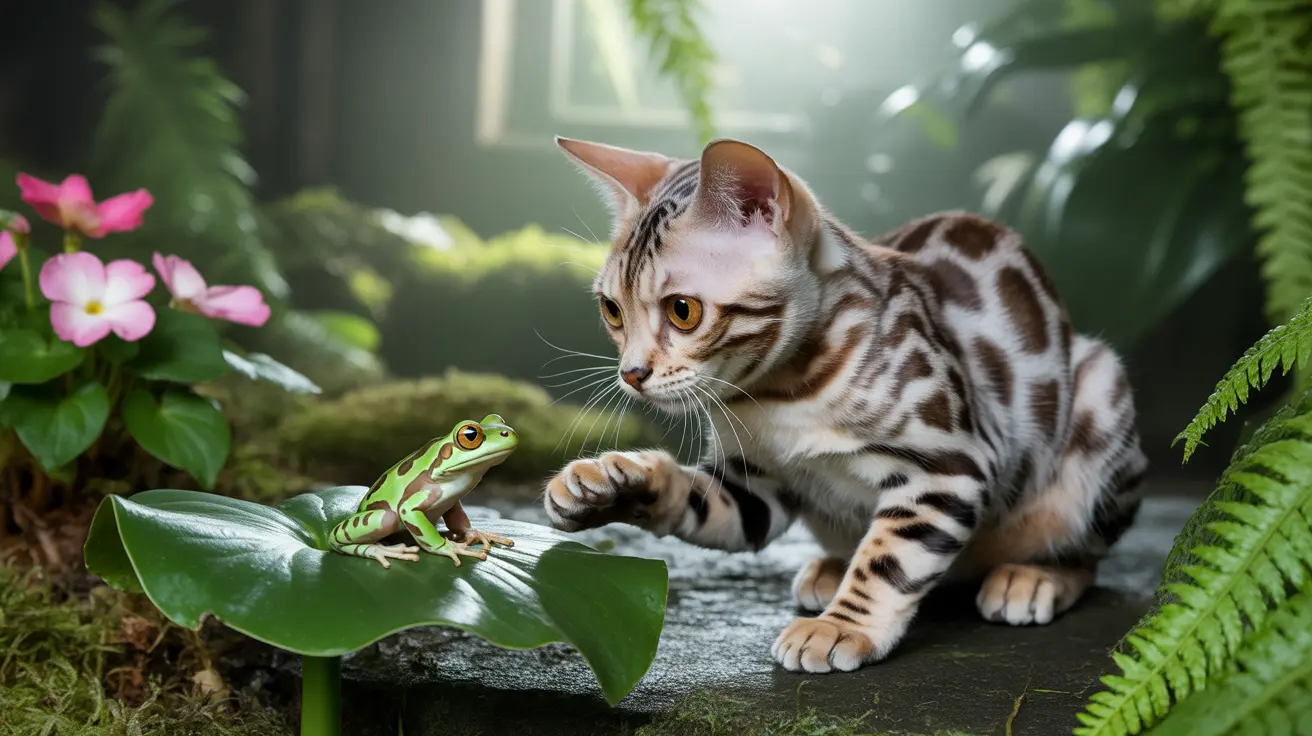For cat owners, watching their feline friends stalk and chase frogs can be concerning. While cats are natural hunters with an instinct to pursue these amphibians, it's crucial to understand the potential risks involved. Not all frogs pose a threat to cats, but some species can be dangerous or even lethal if encountered.
In this comprehensive guide, we'll explore the relationship between cats and frogs, identify which species are truly dangerous, and learn how to keep our curious felines safe from potentially toxic encounters.
Understanding the Real Risks of Frogs to Cats
Most common frogs that cats encounter in North America and Europe are generally not poisonous. However, this doesn't mean they're entirely safe. When cats interact with frogs, they may experience mild gastrointestinal upset, primarily due to the frog's defensive secretions or bacteria they carry.
The real danger often comes from misidentification - many cat owners struggle to distinguish between harmless frogs and their more toxic cousins, toads. This distinction can be crucial for your pet's safety.
Toxic vs. Non-Toxic Amphibians
While most native frogs are relatively harmless, several species can pose significant risks to cats:
Dangerous Species
- Pickerel frogs (found in eastern North America)
- Certain tree frogs
- Poison dart frogs (rare in domestic settings)
- Cane toads
- Colorado River toads
Common Non-Toxic Species
- American bullfrogs
- Green frogs
- Spring peepers
- Wood frogs
Warning Signs of Amphibian Poisoning
If your cat has encountered a toxic frog or toad, you may notice these symptoms:
- Excessive drooling or foaming at the mouth
- Pawing at the face
- Vomiting or retching
- Difficulty breathing
- Abnormal heart rhythm
- Seizures or disorientation
- Bright red or irritated gums
Prevention and Safety Measures
To protect your cat from potentially dangerous encounters with frogs:
- Keep cats indoors during peak amphibian activity (dawn, dusk, and after rain)
- Remove standing water sources near your home
- Maintain your yard to minimize amphibian habitats
- Consider installing cat-proof fencing
- Supervise outdoor time in areas known for toxic species
First Aid and Emergency Response
If you suspect your cat has encountered a toxic frog:
- Immediately rinse their mouth with clean water
- Don't let them swallow the rinse water
- Contact your veterinarian right away
- Monitor vital signs and behavior
- If possible, safely photograph the amphibian for identification
Frequently Asked Questions
Are all frogs poisonous or harmful to cats if they catch or eat them?
No, most common frogs are not poisonous to cats. However, certain species, particularly toads like the cane toad and Colorado River toad, can be highly toxic and potentially lethal to cats.
What are the signs that my cat might be poisoned after interacting with a frog or toad?
Key signs include excessive drooling, pawing at the mouth, vomiting, difficulty breathing, seizures, and abnormal heart rhythms. These symptoms can appear within minutes of contact.
How dangerous are cane toads and Colorado River toads to cats compared to other frogs?
Cane toads and Colorado River toads are significantly more dangerous than most frogs. Their toxins can be lethal even in small amounts, while most frogs might only cause mild digestive upset.
Can non-toxic frogs still make my cat sick, and how do I prevent issues?
Yes, even non-toxic frogs can cause mild illness through bacteria or parasites they carry. Prevent issues by supervising outdoor time and keeping cats away from areas where frogs congregate.
What should I do immediately if I suspect my cat has touched or eaten a toxic frog or toad?
Rinse your cat's mouth thoroughly with water (preventing them from swallowing), and seek immediate veterinary care. Time is crucial in cases of amphibian poisoning.
Conclusion
While not all frogs pose a serious threat to cats, it's essential to remain vigilant and informed about the potential risks. Understanding the difference between toxic and non-toxic species, recognizing warning signs, and knowing how to respond in emergencies can help keep your curious feline safe from harmful encounters with amphibians.
When in doubt, always err on the side of caution and consult your veterinarian if you suspect your cat has had a dangerous interaction with any frog or toad species.






